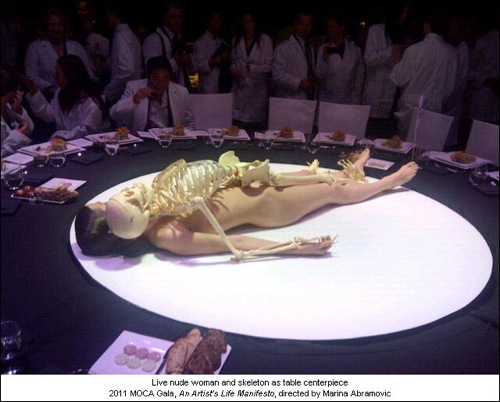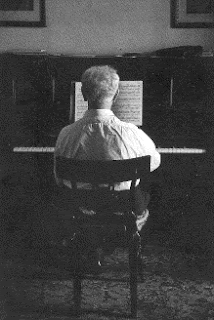Marina Abramovi? has been getting a lot of press in the US of late. The Serb-born performance artist makes extreme demands of herself and her dancers, mostly unclothed. The Los Angeles Times calls her ‘the most successful or recognizable performance artist working today. The New York Times in its smarmy, have-it-both-ways style, characterises her as follows:
Hardly anything Ms. Abramovic says offhand is publishable in this newspaper, any more than are photographs from the performances she has presented over the decades, during which, often naked, she has cut or burned or whipped herself, or put herself in situations the plausible outcomes of which included death.
Despite these constraints, the decadent choreographer does not want for willing performers, who are obliged to sign both a contract and a vow of silence, backed up by threats of a million-dollar lawsuit.
Which makes the following confession all the more remarkable. A dancer, Sara Wookey, keen to work with Abramovi? was offered a role ‘of one of six nude females to re-enact Abramovi?’s signature work, Nude with Skeleton (2002), at the center of tables with seats priced at up to $100,000 each.’


On reflection Sara decided that ‘what I experienced as an auditionee for this work was extremely problematic, exploitative, and potentially abusive.’
So she pulled out and wrote an Open Letter to Artists here. Read it. It is one of the strongest and most coherent I have ever encountered from a performing artist, well on its way to becoming a classic of the blog genre.

Sara Wookey performing “Trio A” at VIVA! Performance Festival in Montreal. Photo credit: Guy L’Heureux
I despair of the Cameron government, I absolutely give up on them as a creative force.
Its cultural policy is in the hands of a pearly pair known as Lazy Hunt-Vaizey  who, eager to spend longer weekends in the country, simply dump unsolved problems work on existing organisations, efficient or otherwise, and tell them to get on with it.
who, eager to spend longer weekends in the country, simply dump unsolved problems work on existing organisations, efficient or otherwise, and tell them to get on with it.
The most dispiriting part of the National Music Plan, announced today, is the decision to make Arts Council England responsible for ‘music education hubs’ around the country. These are meant to ensure that every child between 5 and 18 has access to singing or instrumental lessons.
But why the Arts Council? It’s a funding body with no track record whatsoever in education. It does accountancy, not calculus, and with a vision that ran out before Margaret Thatcher became PM.
However, its Whitehall-trained chief executive Alan Davey is very good at saying Yes Minister. He strikes Lazy Hunt-Vaizey as as safe pair of hands and, since he’s keen to save jobs among his own officials, the fix works nicely for both sides.
Lazy Hunt-Vaizey swans off to the shires and Dozy A Davey can claim a bonus that will take his pay above £200,000 next year.
For the first time since Henryk Mikolai Gorecki took the world by storm with his third symphony in 1991, a work by a contemporary composer has topped the UK classical charts.
It’s A Tender Light by Princess Kate’s wedding favourite, Paul Mealor,

and it may have benefited from Mealor’s appearance this week in Gareth Malone‘s bid to turn the army’s womenfolk into a fighting chorus. It is also top of the specialist classical chart, not the so-called classical chart which is stuffed with the likes of Katherine Jenkins.
But, small cavils aside, it’s a good record and I’m really chuffed for Mealor.
Somebody at Sony has gone down into the Columbia vaults and found all these ancient recordings that are not earning their keep. So the plan is to issue them in mega-editions that will take up so much space on your shelf there will be no room for other records. Clever, huh?
First to get the mega-treatment is Arthur Rubinstein. Sony are putting him out next month in an edition of 142 CDs, 2 videos and a glossy book for the holiday season. Biggest ever, they say. It’s the complete Rubinstein, apparently, including all the RCA and EMI sessions.

But haven’t they forgotten something? There were some Decca sessions that drove poor John Culshaw to distraction (see my history of recording for the full story). Universal must have refused to release them to a rival.
Oh, and this is not the first ‘complete’ Rubi. The last one came in 94 CDs.
And, as an alert reader quickly pointed out, the complete Bach from Hänssler comes with 172 CDs. So this is just the biggest single-artist CD box.
Here’s the press release:
Arthur Rubinstein –
The Complete Album Collection
Catalogue number 88697911362
Label Sony Classical
Price Point Budget
Format 142 CD + 2 DVD
Release date 5th December 11
Arthur Rubinstein is widely considered to be the greatest pianist of the 20th Century. He received 5 Grammy Awards between 1960-1978 for his recordings in both Chamber Music and Solo Instrumental categories and received a posthumous lifetime achievement in 1994.
Arthur Rubinstein – The Complete Album Collection is a Guinness World Record breaking product. The world’s biggest CD edition for a solo artist, it features 142 CDs and 2 Bonus DVDs from this legendary artist, all housed in a stylish cerise box with a comprehensive 164-page full colour hardback book.
142-CD plus 2-DVD limited edition
- The complete studio and live recordings of solo, concerto and chamber music repertoire on RCA Red Seal in their best re-mastered versions. Includes all EMI recordings [originally released on RCA]
- Three new Chopin and one new Debussy work added to the discography
- First-ever release of a whole Chopin Collection
- More than 3 ½ hours of previously unreleased music
- Highlights from Rubinstein’s 1961 Carnegie Hall recitals [‘50th Anniversary Special Releases’]
- Rubinstein Remembered, a documentary tracing the great pianist’s life.
- The Benefit Recital for Israel, (1975)
- 164-page full-coloured hardcover book in landscape format includes
- New liner notes by Rubinstein biographer Harvey Sachs
- Essay by John Rubinstein
- Photos shot and selected by Eva Rubinstein
- Essay on Rubinstein’s 1961 Carnegie Hall recitals
- Complete discography in alphabetical and chronological order, featuring 78s, 45s and LPs
- Track listings with complete discographical notes
The world’s newest concert showcase has run into trouble.
Opened at the end of August, Helsinki’s Musikktaalo was everything the Finns have dreamed of since independence – a space where Sibelius can finally breathe. But word reaches me that both chief executives, Kenneth Katter and Helena Hiilvirta have resigned or been fired.
Insiders tell me that the problem arose from a spiralling graph of running costs. The house is apparently understaffed on the maintenance side and the operators are refusing to release more funds to support its smooth running.

Katter, a technocrat, was brought in to assist the visionary Hiilvirta (above) who, as intendant of the Finnish radio orchestra, had been driving the project from its inception. It was Helena who attracted the Vienna Philharmonic and other blue-chip orchestras to visit Finland for the first time on the promise of a marvellous acoustic. I hope they don’t arrive to find the doors locked for want off staff.
A musician in Exeter claims to have found a critical error in the current edition of the published score of Stravinsky’s Rite of Spring. Marion Wood says one timpani part is missing in The Glorification of the Chosen One section, and what ought to be ping-pong between two timps is mostly played nowadays as a monologue. It has been that way, she says, since the present score was printed in 1967.
The publisher, Boosey & Hawkes, has promised to look into it.
The research shouldn’t take them long. There are two recordings of the work by Stravinsky himself and at least three by Pierre Monteux, who conducted the uproarious first performance in Paris in May 1913. 
Ms Wood will perform the Rite the correct way next Thursday.





 who, eager to spend longer weekends in the country, simply dump unsolved problems work on existing organisations, efficient or otherwise, and tell them to get on with it.
who, eager to spend longer weekends in the country, simply dump unsolved problems work on existing organisations, efficient or otherwise, and tell them to get on with it.



